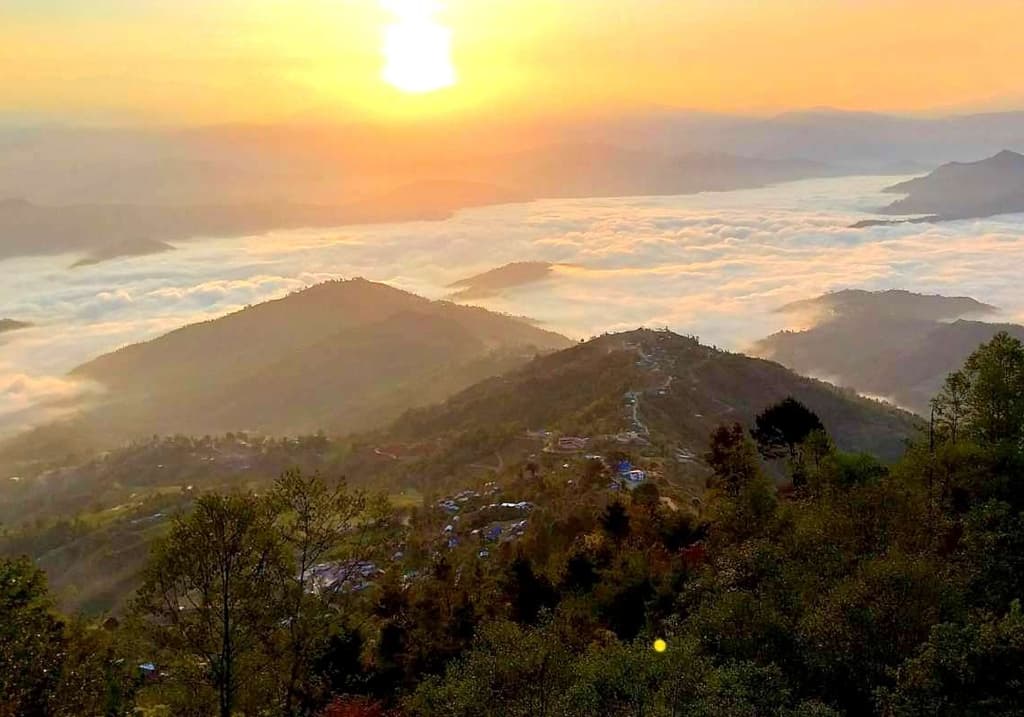Food Habits During Trekking In Nepal
Trekking in Nepal's Himalayas is an adventure that many yearn for. From the iconic trails of Everest and Annapurna to the mesmerizing paths of Langtang and Manaslu, every step is a blend of challenge and beauty. One key to conquering these trails lies in the plate. Consuming high-quality, nutrient-dense meals is paramount, as the journey demands immense physical exertion.
The food options available across these trekking regions bear striking similarities. As trekkers ascend these majestic heights, they encounter a menu tailored for the trekking community. The cuisine ensures that adventurers are fueled appropriately for the taxing trails. Not only do these meals offer a taste of local culture, but they also provide the essential energy and nutrients to keep trekkers going.
When in the Himalayas, dishes like Dal Bhat, a wholesome combination of lentil soup and rice, and Thukpa, a hearty noodle soup, become more than just meals; they are energy lifelines. Incorporating these food habits and prioritizing hydration can make a significant difference in one's trekking experience. For those aiming to conquer the Himalayan trails, remembering the importance of diet can indeed be the difference between a challenging trek and a rewarding expedition.
Foods During Trekking in Nepal
Throughout their journey in Nepal, travelers will discover an extensive range of Nepalese food items in guest houses, homestays, and local restaurants. Additionally, a selection of international cuisines is also available to cater to diverse palates.
Here is a list of some foods during trekking in Nepal.
Breakfast at Trekking Routes of Nepal
Breakfast serves as the day's foundational meal, setting the tone for the day's adventures. It's especially vital when you're embarking on demanding activities, such as trekking in the Himalayas. Typically, trekkers fuel up around 7 a.m., ensuring they're energized to reach their day's destination punctually.
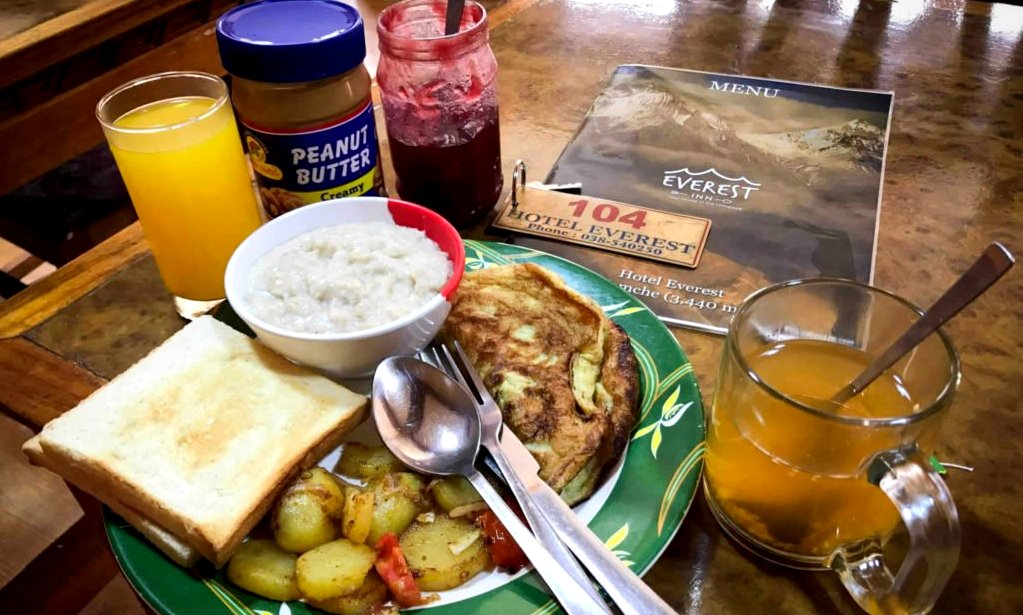
The breakfast spread in Nepal's trekking regions is both hearty and diverse. Travelers can indulge in a range of foods, from toasted bread, eggs, and beads to pancakes and porridges. Complementing these staples are refreshing beverages like coffee, tea, hot lemon, or juice, providing both warmth and hydration for the journey ahead.
Lunch at Trekking Routes of Nepal
Lunch holds a special place in the Nepali culinary culture, often being the most anticipated meal of the day. On the trekking routes of Nepal, the significance of lunch is not just about satisfying hunger, but also refueling for the challenges ahead. Among the plethora of dishes available, one stands out as the quintessential Nepali lunch: Dal Bhat.
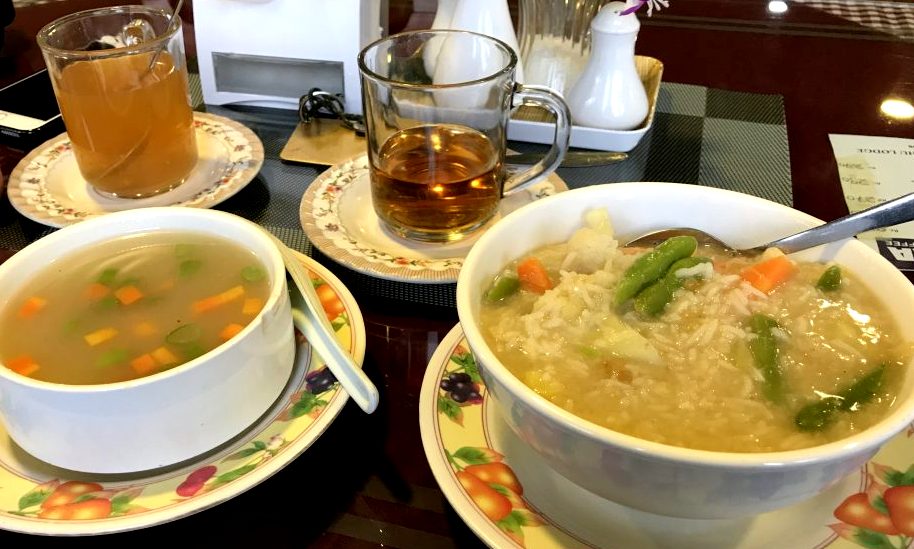
Dal Bhat is not just a meal; it's an emblem of Nepali hospitality and tradition. The dish primarily comprises plain rice, hearty lentils (dal), delectable vegetable curry (Tarkari), and tangy pickles (achar). One of the charming features of having Dal Bhat in local teahouses or eateries is the generous refill option. For the price of a single plate, you can top up any component of the meal, ensuring trekkers are well-fed and energized for their journey.
The culinary landscape of Nepal's trekking trails is not limited to just Dal Bhat. A mosaic of flavors awaits trekkers, with a fusion of traditional and international dishes. Offerings range from the beloved mo:mo (dumplings) and thukpa (noodle soup) to more global favorites like noodles, spaghetti, pizza, and sandwiches. Each dish, while retaining its essence, might come with a Nepali twist, making lunchtimes a delightful culinary exploration.
Dinner at Trekking Routes of Nepal
After a long day of trekking, the tea houses dotting Nepal's trails offer trekkers a warm haven and a delicious meal. These traditional establishments, often set against picturesque backdrops, are where adventurers rest for the night. Within their cozy confines, as evening settles, the aromas of dinner preparations signal it's time to gather. Typically, dinner is served between 7 pm and 8 pm, a time when trekkers share stories and bond over their shared experiences.
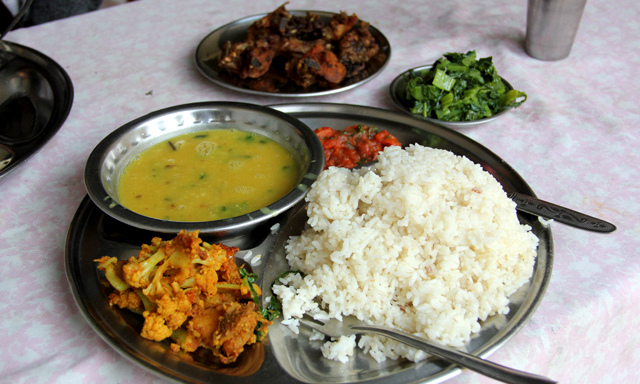
Central to the dinner menu is the iconic dal bhat tarakari. This quintessential Nepali dish, with its rich lentil soup, rice, and vegetable curry, provides both comfort and much-needed nutrients for weary trekkers. Its hearty nature ensures that travelers are replenished and ready for the next day's adventures.
The culinary offerings of the tea houses don't stop at dal bhat. For those craving diverse flavors, dishes like thukpa and spaghetti can be requested. Additionally, trekkers can quench their thirst with a variety of hot and cold beverages, making sure they're hydrated and warmed up in the chilly mountain evenings. Whether it's a traditional Nepali tea or a refreshing cold drink, options abound to suit every palate.
Food Habits To Follow While Trekking in Nepal
Trekking in Nepal offers not just awe-inspiring landscapes but also an opportunity to immerse oneself in the unique culinary traditions of the region. As one navigates through the iconic trails of the Himalayan region - spanning the Everest Region, Annapurna Region, Manaslu Region, Langtang Region, and Dhaulagiri Region - understanding and adopting the local food habits becomes essential. These dietary practices have evolved over centuries to suit the demands of high-altitude trekking and ensure the well-being of trekkers.
Having insights into these food habits can profoundly influence one's trekking experience. It's about discerning the nourishing choices from the rest, ensuring sustained energy, and adapting to the region's demands. By familiarizing themselves with these practices, trekkers can make informed decisions about what to consume, optimizing their health and stamina for the challenges of Nepal's trekking trails. After delving into these habits, one can confidently differentiate between beneficial and less favorable food choices for a successful trekking expedition.
Always Start Your Day With Healthy Wholesome Breakfast
Kicking off your day with a healthy breakfast is imperative, especially when gearing up for challenging terrains. A nutritious morning meal acts as a cornerstone, setting the pace and energy levels for the day's trek. This becomes even more crucial when navigating the trails of high-altitude areas, where every ounce of energy counts and stamina is continuously tested.
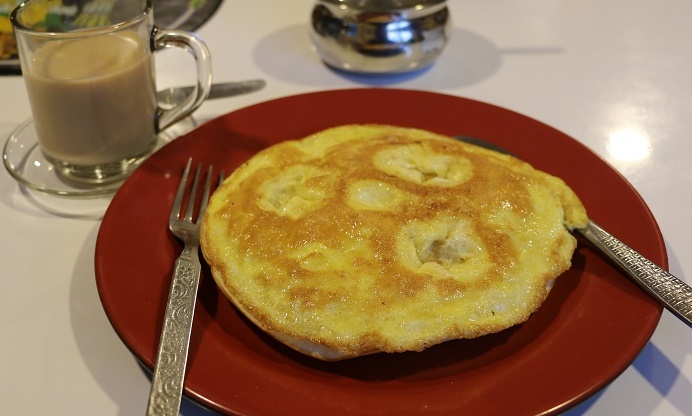
While it's tempting to reach for a caffeine boost, it's advisable to moderate its intake, especially during the early hours. Caffeine can lead to dehydration, a condition trekkers would do well to avoid, given the already demanding nature of high-altitude trekking. Staying hydrated and prioritizing nutrient-rich foods over quick caffeine fixes can make a significant difference in one's trekking experience.
Eat Carbohydrate Containing Foods in Lunch and Dinner Time
Fueling your journey with carbohydrate-containing foods and grains is essential for maintaining steady energy levels throughout the day. Foods rich in carbohydrates, like rice, undergo slow digestion but provide sustained energy, making them perfect for long treks. The slow release of energy helps in ensuring that trekkers have the stamina needed for the grueling trails in the trekking region of Nepal, without experiencing abrupt energy crashes.
Ensuring a balanced intake of these energy-rich foods during lunch and dinner is crucial for averting health complications on the trek. A well-planned meal strategy, focusing on whole grains and carbohydrate-rich foods, assists in minimizing health risks, ensuring trekkers remain in optimal condition throughout their journey. This dietary approach not only enhances physical stamina but also contributes to overall well-being during the challenging trek in the Himalayan terrains.
Carry some Dry Fruits With You
Eating dry fruits like dates, nuts, and raisins into your trekking diet is an excellent way to ensure a quick and natural energy boost. These nutrient-dense snacks are not only portable but also provide a mix of essential vitamins, minerals, and healthy fats, making them perfect companions for the demanding trails of trekking.
However, sourcing these energy-packed dry fruits in the upper trekking region of Nepal can be challenging. When available at higher altitudes, they often come with a premium price tag compared to the lower regions and city areas. Given this, trekkers are advised to include a sufficient quantity of dry fruits in their trekking provisions. These can be consumed during brief rest stops or even on the go, ensuring a consistent energy supply throughout the journey.
Avoid Carrying Cream Biscuits and Sugar Candies
Indulging in creamy biscuits and sugar candies might lead to a sore throat, potentially hampering your trekking experience. Instead, opting for oaty biscuits is a smarter choice. These not only prevent throat irritations but also deliver sustained energy to the body, essential for long treks.
Keep Yourself Hydrated During Trek
Maintaining hydration during a trek is pivotal to ward off muscle cramps and to ensure oxygen levels don't dip in high-altitude zones. To achieve this, a daily intake of at least 6 liters of water is recommended.
Starting your day with ample hydration, particularly before embarking on the trek, aids in balancing digestion and invigorating you for the hike ahead.
While staying hydrated is crucial, ensuring the purity of the water you consume is equally vital. When trekking in the Himalayan regions, it's prudent to arm yourself with water bottles and water purifying tablets, guaranteeing that every sip is free from contaminants.
Proteinous Foods Take a Longer Time To Digest
In higher altitude zones, protein-rich foods like meat demand a longer digestion time, making them less optimal for trekking. It's advisable to limit such foods while on the trail. However, incorporating eggs into your diet can be beneficial. Eggs not only help prevent muscle loss but also aid in repairing broken-down muscle proteins, ensuring you remain in peak physical condition throughout your trek.
Avoid Energy Bars and Chocolate
Chocolates and energy bars, often laden with sugar and corn syrup, provide an immediate energy surge. This quick boost is followed by an eventual drop in the energy cycle, leading to an unstable and undesirable energy peak.
Avoid Alcohol Drink
Consuming alcoholic drinks before or during a trek can have detrimental effects on a trekker's well-being. Alcohol acts as a diuretic, leading to increased dehydration, a condition that can further escalate the risk of Acute Mountain Sickness (AMS), especially in the challenging environment of the Himalayas.

For a successful and safer trekking experience in the Himalayan regions, it's prudent to abstain from alcohol. Avoiding it not only ensures optimal hydration but also significantly reduces the chances of falling prey to altitude-related illnesses such as AMS.
Conclusion
The diverse terrains and altitudes of Nepal's trekking trails demand strategic and informed food choices. The essence of successful trekking in the Himalayas isn't just about physical stamina, but also about understanding the region's dietary nuances. Adhering to local food habits, which have evolved over generations to complement the region's challenges, can make a significant difference in one's overall trekking experience.
From maintaining hydration and moderating caffeine to choosing nutrient-rich foods, trekkers need to be discerning in their dietary decisions. Prioritizing carbohydrates, limiting proteins, and avoiding quick energy fixes are vital in demanding trekking conditions. Moreover, understanding the risks of dehydration due to alcohol is essential for those navigating the high-altitude challenges of Nepal.
Crafted by the insights and experiences of Luxury Holidays Nepal, this guide aims to prepare trekkers for the culinary journey that accompanies the physical one. By taking a holistic approach to food and hydration, trekkers can optimize their health, energy, and overall experience, making every step in the Himalayas both enjoyable and rewarding.
If you need any further information, please contact us by email: [email protected], Phone: +977- 985 100 5129 (WhatsApp)
#Tags
Tripadvisor
5.0928 reviewsGoogle
4.8114 reviewsFacebook
4.1 recommend44 ReviewsTrustpilot
4.1 Great(5 reviews)- Trusted by50K plus traveller




